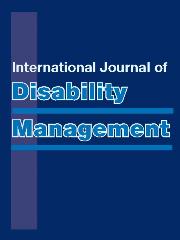Article contents
Posttrauma Employability of People With Symptoms of PTSD and the Contribution of Work Environments
Published online by Cambridge University Press: 23 February 2012
Abstract
The role of work environments in employability was examined at approximately 8 months postaccident in a sample of 69 trauma-exposed, injured adults with and without PTSD. Results showed that participants with PTSD reported significantly lower employability than those without PTSD and this translated into significantly poorer return-to-work rates. Two work environment dimensions, low work support and poor organisational structure, were significantly associated with low employability in the sample. Low levels of work support were significantly related to high PTSD symptom severity. A combination of 3 variables, PTSD symptom severity, physical functioning, and workplace organisational structure, accounted for 60% of variation in employability. Interventions in the workplace should aim to minimise and accommodate PTSD symptomatology and physical dysfunction. In addition, this study has also shown that workplace-based interventions should be aimed at clarifying expectations about job tasks, and promoting moderate managerial control in the workplace. These factors should be considered for inclusion as standard disability management practices for this population.
- Type
- Articles
- Information
- Copyright
- Copyright © Cambridge University Press 2006
- 4
- Cited by


